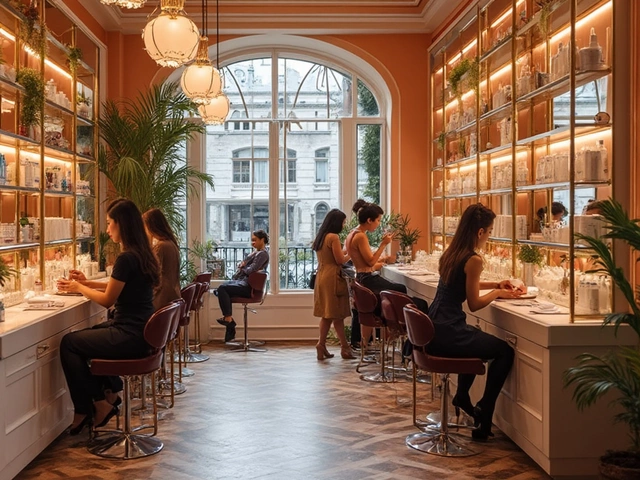Beauty salons, those vibrant hubs of self-care and transformation, have been adored for their ability to enhance appearances and uplift spirits. While many cherish the personal touch of a trusted stylist or the relaxation of a spa treatment, an intriguing question to ponder is whether they rake in a substantial amount of money.
Let's peel back the layers and examine what drives the financial success of these aesthetic oases. From understanding the diverse revenue streams salons tap into, to scrutinizing the influence of location on their profitability, we embark on an exploration that will illuminate the true financial dynamics behind running a beauty salon.
Along the way, we'll touch upon the costs of running such businesses and the essential strategies that can elevate their income potential. Welcome to an inside view of the beauty industry's monetary heartbeat.
- Understanding Salon Revenue Streams
- Influence of Location on Profitability
- Operational Costs and Management
- Strategies for Boosting Income
- Future Trends in the Salon Industry
Understanding Salon Revenue Streams
Delving into the world of beauty salons often leads to one fundamental question: where exactly does their money come from? One of the intriguing aspects of salons is their diverse range of revenue streams that extend well beyond basic haircuts. A significant chunk of their income comes from specialized services. Think of hair coloring, keratin treatments, and elaborate bridal updos. Each of these services can carry a premium price tag, catering to unique customer needs while also elevating the average ticket price per client.
Another substantial piece of the income puzzle is retail sales. Almost every salon stocks a selection of beauty products like shampoos, conditioners, styling tools, and skincare products. These sales can constitute a significant percentage of a salon's revenue. Retail products not only enhance client satisfaction by allowing them to continue their salon regimen at home, but they also offer a lucrative margin for the business. Retail sales often see an upswing during festive seasons or when bundled in promotions.
Additionally, salons creatively expand their financial base by offering membership packages or loyalty programs. For a fixed monthly fee, clients can avail themselves of services like unlimited blowouts or seasonal facials, offering salons a steady stream of income. It’s a strategic revenue model that encourages frequent visits and deepens client relationships. According to a study by the Professional Beauty Association, "Membership programs in salons can boost customer retention by up to 30%."
The role of partnerships should not be underestimated in the revenue equation. Collaborations with local businesses, events, or influencers can open the doors to new client bases while enhancing brand visibility. Hosting occasional workshops or seminars, such as hairstyling tutorials or skincare sessions, can serve dual purposes: fostering community engagement and driving service bookings and product sales.
Interestingly, some salons have ventured into training and certification courses. Offering courses for budding stylists or cosmetologists not only generates income but also positions the salon as an industry authority. It's an excellent opportunity to monetize skills and contribute to the growth of the beauty community.
Salon profitability can also hinge significantly on leveraging online platforms. Social media presence, online bookings, and partnerships with style influencers can amplify reach and attract tech-savvy generations. This digital angle not only expands clientele but can also lead to increased product purchases and service bookings. All of these avenues combined highlight the multifaceted nature of a salon's financial structure, offering multiple layers to prosper in the ever-evolving beauty industry.
Influence of Location on Profitability
When it comes to running a successful beauty salon, the mantra "location, location, location" holds significant weight. The choice of where to establish your salon can dramatically tip the scales of profitability. Urban areas, bustling with foot traffic and a higher population density, often provide beauty salons with an ample customer base ready to indulge in a range of grooming services. The pulse of city life can ensure a steady stream of clients eager to keep up with the latest beauty trends.
Establishing your salon in affluent neighborhoods can be particularly advantageous. Patrons in these areas often have greater disposable income, which they are willing to spend on premium services. This opens up opportunities for beauty salons to offer specialized and high-end treatments, commanding higher prices and, in turn, increasing revenue potential. Conversely, salons in smaller towns or rural areas may face challenges in attracting customers due to lower population density and limited diversity in demand.
Visibility and accessibility are other crucial factors tied to location. A salon in a busy shopping district or near prominent landmarks not only attracts attention but also makes it easier for clients to drop by, even without prior appointments. Besides, proximity to public transport hubs or parking facilities enhances convenience, a crucial selling point for many customers. Imagine you’re running errands downtown—would you opt for a well-located salon or one hidden in a quiet alley?
Market research is an indispensable step for understanding the local competition and gauging demand for salon services. An area saturated with salons may necessitate a more distinctive brand, offering services that stand out to draw in clients. Alternatively, opening in a high-demand area with few competitors can position a salon as the go-to choice in that community.
"The success of any salon is greatly dependent on its location," notes Sarah King, an industry analyst.
"Being in the right spot can mean the difference between thriving and merely surviving in the beauty business."Urban versus suburban placements can also influence operating costs, with city-based salons typically facing higher rents than those in less densely populated areas, requiring precise financial planning to maintain profitability.

Operational Costs and Management
Delving into the intricate framework of running a beauty salon unravels a tapestry of operational costs that salon owners must skillfully weave through to maintain a flourishing business. From the outset, rent and utilities form a significant chunk of these expenses, especially when location is prime. Salons nestled in upscale neighborhoods often encounter sky-high leases, meaning salon managers must strategize meticulously to ensure that these costs don't overshadow potential profits. This real estate factor intertwines deeply with the salon's visibility and footfall, which can bolster revenue streams if managed adeptly.
Then there's the indispensable investment in salon supplies which brings another layer of complexity. Product inventory, including high-end shampoos, conditioners, coloring agents, and maintenance products, demands a continuous replenishment that can dent financial reserves if not judiciously monitored. Partnering with trusted suppliers, negotiating bulk deals, and staying updated with industry trends in product usage becomes crucial to keep both customers happy and costs in check. As the industry evolves, salons often update their product lines to incorporate sustainable and organic options, reflecting broader consumer interests.
"Running a successful salon requires a keen eye for detail in cost management and the ability to pivot strategies to meet client's needs and market changes," says Sarah Giles, a veteran salon consultant and industry expert.
Staff wages are another pillar supporting the salon's operational structure. Skilled stylists, masseuses, and estheticians form the backbone of the beauty business, desiring remuneration that reflects their expertise and ensures job satisfaction. Competitive pay combined with attractive incentives can reduce turnover rates, saving additional recruitment and training expenditures. Moreover, investing in employee development through specialized training programs and workshops can yield bountiful returns, as a well-trained staff translates to an enriched client experience.
Technology and Maintenance
Beneath the polished surface of a thriving salon lies the hidden realm of technological needs. Customer management software and scheduling systems revolutionize how salons operate, bringing efficiency in bookings, billing, and customer relationship management. These systems, while essential, involve upfront installation costs and subscriptions that add to the business's pecuniary responsibilities. Equally important is the maintenance of salon equipment; from hairdryers to steaming machines, regular servicing ensures seamless operations, precluding costly breakdown implications.
Alongside these tangible factors, intangible costs such as insurance and marketing should not be underestimated. Liability insurance safeguards the establishment against potential mishaps, provided it's carefully selected to cover all operational aspects. Meanwhile, a robust marketing plan, encompassing social media outreach and local advertising, can drive customer traffic and awareness. Allocating budget for these domains meticulously aligns with the salon's growth objectives while keeping expenditures sustainable.
Adapting Management Strategies
A salon's management team must blend these elements into a cohesive strategy that aligns with their vision and market demands. Adapting management strategies such as flexible scheduling, customer loyalty programs, and service bundles can heighten client retention and satisfaction. The more a salon resonates with the community it serves, the more robust its financial standing becomes. On an operational level, leveraging data analytics allows management to make informed decisions about staffing, service offerings, and promotional endeavors, aligning them with consumer preferences and economic trends.
Further supporting such plausible transformations, it is vital to remain financially astute and set aside a contingency fund for unforeseen expenses or economic fluctuations that could affect salon income. This approach acts as a buffer, providing security against a volatile climate and allowing salon owners to navigate the business with resilience.
Strategies for Boosting Income
In the bustling world of beauty salons, increasing revenue isn't just about expanding the client base but also maximizing each customer's value. Savvy salon owners understand that the fusion of services and products can significantly elevate earnings. A robust strategy involves upselling or cross-selling related services during client visits. Imagine a client coming in for a haircut; introducing a complementary service such as a nourishing scalp treatment or a trendy hair gloss can add value to their experience while inflating the transaction size. Equipping staff with the skills to subtly recommend these enhancements without pushing a hard sell is critical in maintaining customer satisfaction and loyalty.
Effective branding and marketing play a pivotal role in attracting new clientele while retaining existing ones. Establishing a strong online presence is a non-negotiable in today's digital age. Crafting engaging social media content showcasing transformations, testimonials, and behind-the-scenes moments can captivate potential clients' attention. Incorporating customer-generated content where patrons share their salon experience can foster community trust and act as subtle endorsements. Email marketing, although older, remains potent if personalized — clients appreciate receiving targeted promotions or birthday discounts that add a personal touch.
"Success in the beauty industry often hinges on genuine connections and targeted strategies," notes renowned industry expert Jane Harris. "Salons that thrive are those that see beyond services, viewing each customer interaction as an opportunity to enhance loyalty and trust."
Loyalty programs serve as another potent tool to boost income. Rewarding repeat customers with discounts or exclusive offers encourages ongoing engagement. Such initiatives not only increase frequency of visits but also grassroots promotion as satisfied clients become brand ambassadors. Another ingenious way salons can boost income is by renting chairs to independent stylists, which ensures income while diversifying service offerings.
Education and innovation are key ingredients for staying competitive. Regular training sessions for staff keep them abreast of industry trends, enabling salons to offer cutting-edge styles and treatments that attract style-conscious customers. Partnering with local businesses for joint promotions or pop-up events can also extend a salon's reach, tapping into different customer segments and driving traffic.
Understanding your market inside out allows for strategic pricing models tailored to the clientele’s spending habits. High-end salons may cater to a different demographic than a neighborhood favorite spot, and pricing should reflect this understanding without alienating potential customers. Lastly, embracing eco-conscious practices and products can attract a growing demographic of environmentally sensitive patrons, paving the way for new revenue streams.

Future Trends in the Salon Industry
The beauty industry, ever-evolving and dynamic, is poised for intriguing shifts as we move toward the middle of the decade. One compelling trend is the growing integration of technology with beauty services. Technological advancements are leading the way, where augmented reality apps offer personalized virtual makeovers to assist clients in choosing the right style or color without stepping foot into a beauty salon. This not only enhances customer experience but also helps salons streamline their consultation processes, boosting efficiency.
Another aspect making waves is the increasing demand for sustainability within salons. Clients are becoming more conscientious about the ecological impact of their beauty routines. Many beauty salons have started adapting by using organic products, implementing greener business practices, and promoting eco-friendly packaging. This shift not only attracts environmentally conscious clients but also sets salons apart in a competitive market. According to the Green Business Bureau, "Sustainability isn't just a trend; it's a business imperative, and the beauty industry is no exception."
Alongside technology and sustainability, personalization is carving its niche. Customers today crave services that cater specifically to their unique preferences and needs, causing a surge in bespoke beauty services. Salons are offering customized product lines and tailored treatments to meet this rising demand, ensuring that every client leaves feeling truly attended to and valued. The personalization trend is boosting client loyalty and retention, translating into long-term success for salon businesses.
The role of social media and digital marketing can't be overlooked either. More salons are leveraging platforms like Instagram and TikTok to connect with potential clients, showcase their artistry, and build a community. Virtual consultations and tutorials via social media are becoming common practice, allowing salons to maintain engagement with clients beyond the chair, nurturing relationships that contribute to ongoing business growth. A report by Statista indicates that 51% of consumers now turn to social media for beauty advice, underscoring its influence.
Lastly, the rise of wellness-focused services is redefining beauty salon offerings. As the line between beauty and wellness continues to blur, salons are beginning to incorporate holistic treatments that cater to both physical appearance and emotional well-being. Services such as mindfulness-based facials, aromatherapy, and stress-relief massages are becoming part of regular salon menus, reflecting a growing appetite for integrated beauty and wellness experiences.
In conclusion, the future of the beauty industry shines bright with opportunities rooted in technology, sustainability, personalization, and wellness. Salons that adapt to these changes not only promise growth and profitability but also resonate with the evolving aspirations of their clientele, ensuring they remain at the forefront of beauty and style.


